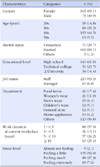Abstract
Purpose
The purpose of this study is to explore violence experienced by workers in the distribution industry.
Methods
The research subjects were 236 workers from 2 department stores and 1 large scale discount store located in Daejeon City, Korea. The collected data were analyzed through descriptive statistics, χ2-test, and logistic regression analysis.
Results
72.9% of the research subjects experienced verbal violence, and 9.3% of the respondents experienced physical violence during last year. 17.8% of the respondents reported that they had experience of sexual harassment at their workplaces. The variables which affected verbal violence included working departments and stress level, whereas the variable that affected physical violence was educational level of workers. The variables that affected experience of sexual harassment turned out to be gender as well as the duration of work at the current workplaces.
Conclusion
The findings from this research revealed that many of the workers engaged in the distribution industry were exposed to workplace violence. For the reduction of risk of workplace violence for these workers, it is required to develop and execute programs including violence related policies and education about workplace violence.
Figures and Tables
References
1. Braun K, Christle D, Walker D, Tiwanak G. Verbal abuse of nurses and non-nurses. Nurs Manage. 1991. 22(3):72–76.
2. Byun CB, Youn K, Jung-Choi K, Cho Y, Paek D. Depressive symptoms of workplace violence exposed subjects in Korea. Korean J Occup Environ Med. 2009. 21(4):314–323.
3. Forster JA, Petty TM, Schleiger C, Walter H. Know workplace violence: Developing programs for managing the risk of aggression in the health care setting. Med J Aust. 2005. 183:357–361.
4. Hwang EA. Nurse abuse: The meaning of the lived experience. 1993. Seoul: Ewha Womans University;Unpublished master's thesis.
5. International Council of Nurses. Position statement: Abuse and violence against nursing personnel. 2006. Retrieved September 20, 2009. from http://www.icn.ch/images/stories/documents/publications/position_statements/C01_Abuse_Violence_Nsg_Personnel.pdf.
6. International Labour Office. International Council of Nurses. World Health Organization. Public Services International. Framework guidelines for addressing workplace violence in the health sector. 2002. Retrieved September 20, 2009. from http://www.who.int/violence_injury_prevention/violence/interpersonal/en/WVguidelinesEN.pdf.
7. Jang SJ. Relationship between experience of patients' violence behaviors and burnout of psychiatric nurses. 2004. Seoul: Seoul National University;Unpublished master's thesis.
8. Kim SY. Analysis of research about workplace violence owards hospital nurses in Korea. Paper presented at the meeting of the World Congress on Safety and Health at Work. 2008. Seoul, Korea:
9. Kim SY, Ahn HY, Kim HS. Violence experiences of clinical nurses and nurse aids in hospitals. Korean J Occup Health Nurs. 2008. 17(1):76–85.
10. Kim TS, Kim JI. Violence episodes and turnover among clinical nurses. J Korean Acad Nurs Adm. 2004. 10(4):427–436.

11. National Institute for Occupational Safety and Health. Violence: Occupational hazards in hospitals. 2002. Retrieved November 15, 2009. from http://www.cdc.gov/niosh/2002-101.html.

12. Occupational Safety and Health Administration. Guidelines for preventing workplace violence for healthcare and social service workers. 2004. Retrieved September 20, 2009. from http://www.osha.gov/Publications/osha3148.pdf.
13. Occupational Safety and Health Administration. OSHA instruction: Enforcement procedures for investigation or inspecting workplace violence incidents. 2011. Retrieved September 20, 2009. from http://www.osha.gov/OshDoc/Directive_pdf/CPL_02-01-052.pdf.
14. Park E, Kim J. The experiences of workplace violence toward nurses in hospitals in jeju province, South Korea. Korean J Occup Health Nurs. 2011. 20(2):212–220.
15. Rippon TJ. Aggression and violence in health care profession. J Adv Nurs. 2000. 31(2):452–460.
16. Shin JS, Kim YB. Client violence against social workers in community welfare centers. Korean Policy Sci Rev. 2009. 13(1):167–189.
17. University of Iowa Injury Prevention Research Center. Workplace violence: A report to the nation. 2001. Retrieved November 20, 2009. from http://www.public-health.uiowa.edu/iprc/resources/workplace-violence-report.pdf.




 PDF
PDF ePub
ePub Citation
Citation Print
Print







 XML Download
XML Download